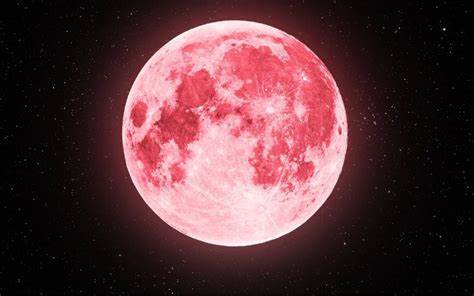
Over the next several days, Oregon and the rest of the globe will see another celestial spectacle, just over two weeks after the complete solar eclipse in early April. On Tuesday evening, the full or “pink” moon will rise in the evening sky.

However, the moon won’t truly appear pink to our eyes unless there are certain unanticipated atmospheric occurrences, like smoke from wildfires. The Old Farmer’s Almanac states that the moon should instead be “its usual golden color near the horizon and fade to a bright white as it glides overhead.”
Rather, the name of the full moon in April comes from one of the first common flowers of spring. Observe the following:
In Oregon, when is the full moon in April?
Tonight, on Tuesday, the pink moon will be visible. Tuesday at about 7 p.m. and Wednesday at about 6 a.m. are when the moon will rise and set in Oregon. 12:40 a.m. is when it will be at its highest point in the sky.
The moon rises in Eugene at 7:10 p.m. and in Salem.
For specific rising and setting times based on ZIP codes, see www.almanac.com/astronomy/moon-rise-and-set.
The moon should be visible to Oregonians in the northwest direction of the sky, barring any nighttime clouds.
NASA reported that from Monday am until Thursday early, the moon will appear to be full to us for around three days.

The pink moon: why is it named that?
Native Americans and people all across the world have called the months based on clues from nature for thousands of years. There’s a name for every full moon.
NASA asserts that Native American names for full moons were first published by the Maine Farmers’ Almanac in the 1930s and are now commonly used.
Inspired by the herb moss pink, which is also referred to as creeping phlox, moss phlox, or mountain phlox, the full moon in April is called the pink moon. One of the first widely distributed spring blooms is this plant, which is indigenous to the eastern United States.
According to the Farmer’s Almanac, creeping phlox is suitable for sandy or rocky soils and is frequently utilized as a ground cover.
Due to the fact that this was the time that shad moved upstream to spawn, NASA reported that this moon is also known as the springing grass moon, the egg moon, and the fish moon among coastal tribes in North America.
Additional celestial objects to observe. other than pink moon.
Stargazers who are already enjoying the pink moon may be able to witness the yearly Lyrid meteor shower, which peaks from Sunday night until Tuesday morning.
Some of the falling stars, though, probably won’t be visible because of how bright the full moon is. A clear night sky with no moon makes it simpler to see meteors.
https://youtu.be/W4T6ZyCDRLI?si=_GXIBW3fNNuEtXJ5



















